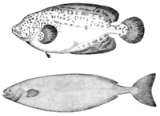
Ragfish
Encyclopedia
The ragfish, Icosteus aenigmaticus (Lockington, 1880), is an odd ray-finned fish of the northern Pacific Ocean
; although a perciform, its skeleton
is mostly cartilage
, and the larva
e have pelvic fins that disappear as they mature. It is the sole member of the family Icosteidae, and some authorities place it into its own order Icosteiformes.
The ragfish body is scaleless and limp, both because of the cartilaginous skeleton, as well as its flabby muscles. None of the fins have any spines. The dorsal
and anal fins extend much of the length of the body, while the pelvic fins are absent. The coloration is generally a dark brown, and maximum known length is two meters.
Ragfishes are found in deeper waters out to sea, and are said to eat other fish, squid
, and octopus
, although recent catches show no squid beaks but large amounts of jellyfish
.
The larvae make a remarkable transformation as they mature; the caudal fin shrinks, and the pelvic fins disappear.
It was considered formerly that adult ragfishes were different species, known then as Acrotus Willoughbyi.
Pacific Ocean
The Pacific Ocean is the largest of the Earth's oceanic divisions. It extends from the Arctic in the north to the Southern Ocean in the south, bounded by Asia and Australia in the west, and the Americas in the east.At 165.2 million square kilometres in area, this largest division of the World...
; although a perciform, its skeleton
Skeleton
The skeleton is the body part that forms the supporting structure of an organism. There are two different skeletal types: the exoskeleton, which is the stable outer shell of an organism, and the endoskeleton, which forms the support structure inside the body.In a figurative sense, skeleton can...
is mostly cartilage
Cartilage
Cartilage is a flexible connective tissue found in many areas in the bodies of humans and other animals, including the joints between bones, the rib cage, the ear, the nose, the elbow, the knee, the ankle, the bronchial tubes and the intervertebral discs...
, and the larva
Larva
A larva is a distinct juvenile form many animals undergo before metamorphosis into adults. Animals with indirect development such as insects, amphibians, or cnidarians typically have a larval phase of their life cycle...
e have pelvic fins that disappear as they mature. It is the sole member of the family Icosteidae, and some authorities place it into its own order Icosteiformes.
The ragfish body is scaleless and limp, both because of the cartilaginous skeleton, as well as its flabby muscles. None of the fins have any spines. The dorsal
Dorsal fin
A dorsal fin is a fin located on the backs of various unrelated marine and freshwater vertebrates, including most fishes, marine mammals , and the ichthyosaurs...
and anal fins extend much of the length of the body, while the pelvic fins are absent. The coloration is generally a dark brown, and maximum known length is two meters.
Ragfishes are found in deeper waters out to sea, and are said to eat other fish, squid
Squid
Squid are cephalopods of the order Teuthida, which comprises around 300 species. Like all other cephalopods, squid have a distinct head, bilateral symmetry, a mantle, and arms. Squid, like cuttlefish, have eight arms arranged in pairs and two, usually longer, tentacles...
, and octopus
Octopus
The octopus is a cephalopod mollusc of the order Octopoda. Octopuses have two eyes and four pairs of arms, and like other cephalopods they are bilaterally symmetric. An octopus has a hard beak, with its mouth at the center point of the arms...
, although recent catches show no squid beaks but large amounts of jellyfish
Jellyfish
Jellyfish are free-swimming members of the phylum Cnidaria. Medusa is another word for jellyfish, and refers to any free-swimming jellyfish stages in the phylum Cnidaria...
.
The larvae make a remarkable transformation as they mature; the caudal fin shrinks, and the pelvic fins disappear.
It was considered formerly that adult ragfishes were different species, known then as Acrotus Willoughbyi.

